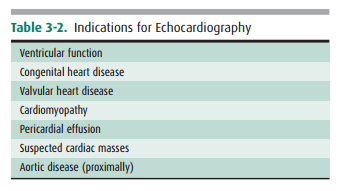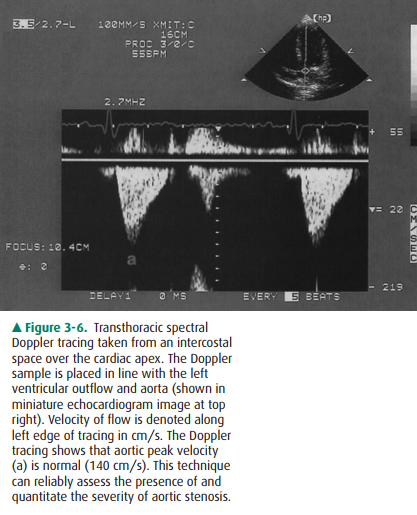Chapter: Basic Radiology : Imaging of the Heart and Great Vessels
Echocardiography
Echocardiography
Echocardiography uses high-frequency ultrasound to evalu-ate the heart and great vessels. The major indications for the technique are listed in Table 3-2.

The examination provides
a dynamic rendition of cardiac great vessel anatomy and, whencombined with the
Doppler technique, yields information re-garding cardiac and great vessel blood
flow (hemodynamics) as well. Because of the high frame rates inherent in
ultra-sonography, echocardiography can image the heart in a dy-namic real-time
fashion, so that the motion of cardiac structures can be reliably evaluated.
Echocardiography is use-ful in assessing ventricular function, valvular heart
disease, myocardial disease, pericardial disease, intracardiac masses, and
aortic abnormalities (Figures 3-5 and 3-6). With Doppler technology, cardiac
chamber function, valvular function, and intracardiac shunts frequently seen in
congenital heart dis-ease can be assessed. Combined Doppler echocardiography is
a commonly performed procedure because it is relatively in-expensive and widely
available, provides a wealth of informa-tion, is noninvasive, has no risk of
ionizing radiation, and can also be performed at the bedside in critically ill
patients. Fur-thermore, the results are immediately available because no
special postexamination image processing is required. How-ever, this technique
is technically challenging and requires a great deal of operator expertise.
Also, a small percentage of patients have poor acoustic windows that can
severely de-grade image quality. This disadvantage can be obviated by placing
the sonographic probe in the esophagus, a procedure called transesophageal
echocardiography (TEE). Trans-esophageal echocardiography yields consistently
excellent images of the heart and great vessels, but involves a small amount of
discomfort and risk to the patient. More recently, echocardiography has been
combined with stress-testing modalities to assess inducible myocardial ischemia
using wall motion analysis of left ventricular function.


Related Topics